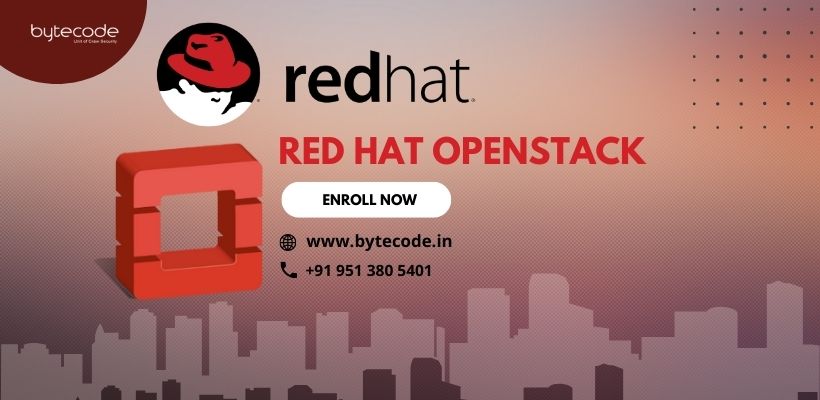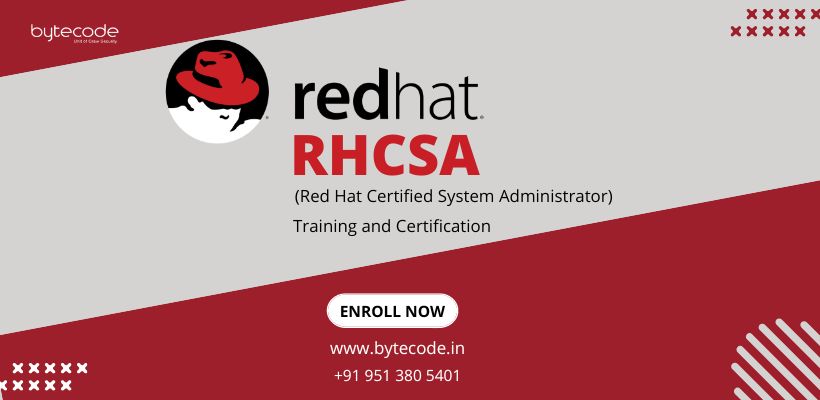Red Hat Certified Architect | Red Hat OpenStack Training in Delhi
Red Hat® OpenStack® Platform is essentially a cloud computing platform that manages resources into clouds, virtualizes resources based on industry-standard hardware, and arranges resources so that end users may access them anytime, anywhere.
To put it simply, OpenStack is an open-source cloud computing platform that creates and manages private and public clouds using virtual resources. The tools that make up OpenStack platforms, which often oversee the many cloud computing services like computation, networking, storage, identification, and image processing, are referred to as “projects.”

What will you learn in Redhat Openstack Training?
Individuals who possess an acceptable degree of expertise as a system administrator may choose to enroll in Red Hat OpenStack Training in the vicinity of New Delhi, where they will receive expert assistance from Red Hat Certified Linux professionals who act as mentors and trainers. Furthermore, a conscientious student will be able to derive a good degree of knowledge from our curriculum that has been fully validated by many Linux professionals who are employed in numerous firms as competent Linux Engineers and Administrators.
Red Hat OpenStack Administration I – Core Operations for Cloud Operators: CL110
With its limitation, this genuine and sincere Red Hat OpenStack Administration I: Core Operations for Cloud Operators (CL110) offers all understudies who are experienced Linux system administrators, cloud administrators, and/or cloud operators an authentic training experience to implement a cloud computing environment using various OpenStack protocols.
The creation, configuration, management, use, maintenance, and troubleshooting of the Red Hat® OpenStack Platform will be taught to a suitably competent individual. Additionally, Red Hat Enterprise Linux 8.2 and Red Hat OpenStack Platform 16.1 are heavily utilized in this training in order to work through and grasp the several basic ideas related to this real and sensitive course.
Red Hat OpenStack Course Module
➜ Module 01: Navigate the Red Hat OpenStack Platform architecture
➜ Module 02: Describe the OpenStack control plane
➜ Module 03: Integrate identity management
➜ Module 04: Perform image operations
➜ Module 05: Manage storage
➜ Module 06: Manage OpenStack networking
➜ Module 07: Manage to compute resources
➜ Module 08: Automate cloud applications
➜ Module 09: Troubleshoot OpenStack operations
➜ Module 10: Cloud computing
➜ Module 11: Red Hat OpenStack Platform
➜ Module 12: Compute, storage, and network about the Red Hat OpenStack Platform
➜ Module 13: High availability with Red Hat OpenStack Platform
➜ Module 14: Deploying Red Hat OpenStack Platform
Key Features of Redhat OpenStack Training Course Outline:
- Introduce launching an instance
- Organize people and resources
- Describe cloud computing
- Manage Linux networks
- Prepare to deploy an instance with public access
- Deploy an instance
- Manage block storage
- Manage object storage
- Prepare to deploy an external instance
- Deploy an instance with public access
- Customize instances
- Deploy scalable stacks
- Install an OpenStack overcloud
Course Content Summary of Red Hat OpenStack Administration I – Core Operations for Cloud Operators: CL110:
Learners enrolled in Red Hat OpenStack Administration I: Core Operations for Domain Operators (CL110) will focus on performing both standard and specialized tasks that are necessary for an OpenStack overcloud production domain’s management. To operate OpenStack, students will use both command-line and web-based interfaces. Among the fundamental skills covered in the course are the following:
- Start instances to fulfill different use case scenarios.
- In a multitenant system, manage domains, projects, users, roles, and quotas.
- Oversee subnets, routers, networks, and floating IP addresses.
- Use access keys and group rules to control instance security.
- Within OpenStack, create and manage objects, shared storage, and blocks.
- Use cloud-init to customize instance launches.
- Utilize stack templates to develop scalable apps.
Red Hat OpenStack Administration II – Infrastructure Configuration for Cloud Administrators: CL210
Red Hat OpenStack Administration II: Infrastructure Configuration for Cloud Administrators (CL210) provides an administrator with training on a variety of features that are very helpful in executing an environment for cloud computing with OpenStack. The knowledge of configuring, allocating, and managing the Red Hat OpenStack Platform infrastructure will undoubtedly be acquired by a committed student.
You will also see that Red Hat Enterprise Linux 8.2 and Red Hat OpenStack Platform 16.1 serve as a great foundation for this premium course.
Key Features of Red Hat OpenStack CL210 Training in Delhi Outline:
- Navigate the Red Hat OpenStack Platform architecture
- Describe the OpenStack control plane
- Integrate identity management
- Perform image operations
- Manage storage
- Manage OpenStack networking
- Manage to compute resources
- Automate cloud applications
- Troubleshoot OpenStack operations
Course Content Summary of Red Hat OpenStack Administration II – Infrastructure Configuration for Cloud Administrators: CL210
- Overcloud service containerization technology management.
- Supplying data for governance and performance optimization.
- Observing and debugging network flow in Open Virtual Networking (OVN).
- Using an external Red Hat IdM store to configure Identity service.
- Controlling the Pacemaker and the main control plane.
- Image customization using methods for various applications.
- Handling block and object storage back-ends.
- Controlling computing nodes, encompassing optimization and hyperconvergence.
- Red Hat OpenStack Platform troubleshooting.
Who should do this OpenStack CL210 Training in Delhi?
Anyone interested in or in charge of managing an individual or hybrid cloud who fits one of the following criteria can complete this real Redhat Openstack Training in Delhi with dedication:
- Linux system administrators,
- Cloud administrators,
- Cloud operators, and
- Infrastructure Architects
- Applicants who genuinely hold the Red Hat Certified System Administrator (RHCSA) certification.
Red Hat OpenStack Technical Overview (CL010)
Red Hat Inc. has created a series of on-demand online taped films called Red Hat OpenStack Technical Overview (CL010) to help learners better understand the foundations of cloud computing and the Red Hat® OpenStack® Platform. The curriculum for this course also includes a number of online case studies and demos.
Many languages, including English (including English with closed captions), Japanese, French, German, Chinese, Spanish, Korean, and Italian are available for this course.
Key Features of Red Hat OpenStack Technical Overview (CL010) Outline:
- Cloud computing
- Red Hat OpenStack Platform
- Compute, storage, and network in relation to the Red Hat OpenStack Platform.
- High availability with Red Hat OpenStack Platform
- Deploying Red Hat OpenStack Platform
Who should do this Red Hat OpenStack Technical Overview (CL010)?
IT leaders, administrators, engineers, architects, and anyone else seeking a high-level understanding of Red Hat OpenStack Platform capabilities.
Students can attend classes from their homes. It takes less time to attend an online class. At the same time, various groups can attend online classes with bytecode Cyber Security From home.
Red Hat OpenStack Certification Training
In order to fully understand Red Hat OpenStack Training in Delhi, one must immerse oneself in studying the fundamentals of Red Hat OpenStack Architecture using Red Hat OpenStack Platform 16, the most recent OpenStack platform version.
A true student must complete Red Hat OpenStack Training with the most knowledgeable cloud security instructors in the Delhi, NCR area to gain access to the essential principles of Red Hat OpenStack Administration. Additionally, Bytecode Cyber Security Institution in Saket and Laxmi Nagar, with a team of knowledgeable cloud security faculty members, is providing its top-notch Redhat OpenStack Training along with comprehensive Red Hat OpenStack Documentation to help students grasp all the finer points associated with the subject of Redhat OpenStack Training.
Red Hat OpenStack Training Course Duration at Bytecode Security
- Course Duration: 60 Hours
- Course Level: Intermediate
- Included: Training Certificate
- Language: English, Hindi
- Course Delivery: Classroom Training
- Course pdf: Click here to Download
Who should do this Red Hat OpenStack Certification Training?
The following profiles, specifically those who are interested in or in charge of managing a private or hybrid cloud, are the target audience for this course:
- Linux system administrators,
- Cloud administrators, and
- Cloud operators.
- Persons who have a genuine Red Hat Certifed System Administrator Certification (RHCSA)
Our Students are placed in Companies




Our Google Reviews
Related Course
FAQ
About Redhat OpenStack Training in Delhi | Redhat OpenStack Training
What is OpenStack used for?
To put it simply, OpenStack is an open-source cloud computing platform that creates and manages private and public clouds using virtual resources. The tools that makeup OpenStack platforms, which often oversee the many cloud computing services like computation, networking, storage, identification, and image processing, are referred to as “projects.”
Is OpenStack IaaS or PAAS?
OpenStack is an Infrastructure-as-a-Service (IaaS) platform. It may also be described as a no-cost, open-source cloud computing platform that is typically used for infrastructure deployment.
Who uses OpenStack?
Many firms use OpenStack to carry out their various levels of job performance. For example, OpenStack powers the majority of the mobile telecom network, including 5G work techniques.
How does OpenStack different from AWS?
Users of AWS and OpenStack can, in general, operate nicely with both programs, uploading their own images, for example. In addition, AWS offers EC2, which is essentially a scalable virtual network with big data analytics based on Hadoop and Xen.
Conversely, OpenStack is typically implemented as an IaaS system that grows horizontally and is designed to grow on hardware without the need for additional configuration.
Is AWS using OpenStack?
No, unlike OpenStack, which offers IaaS infrastructure for all common users as open-source software, AWS does not employ any publicly accessible cloud infrastructures.
What is the difference between Kubernetes and OpenStack?
The primary distinction between OpenStack and Kubernetes is that OpenStack is an open-source cloud technology that is typically utilized as an Infrastructure as a Service (IaaS) platform, whereas Kubernetes is classified as a container tool.
Do I need OpenStack for OpenShift?
OpenStack and OpenShift are two tools that are made to work well in the cloud. OpenStack is designed to work with all cloud service providers, including Google Cloud, AWS, and Azure. Conversely, OpenShift functions as a platform as a service provider.






























